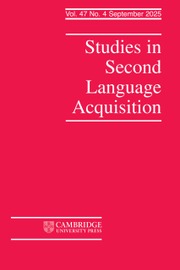Article contents
DIFFERENTIAL EFFECTS OF ORAL AND WRITTEN CORRECTIVE FEEDBACK IN THE ESL CLASSROOM
Published online by Cambridge University Press: 23 April 2010
Abstract
This article examines whether there is any difference between the effect of oral and written corrective feedback (CF) on learners’ accurate use of English articles. To this end, the current research presents the results of a quasi-experimental study with a pretest, immediate-posttest, delayed-posttest design, using 12 intact intermediate English-as-a-second-language classes with adult learners of various first language backgrounds. Five groups were formed: oral recasts (n = 26), oral metalinguistic (n = 26), written direct correction (n = 31), written direct metalinguistic (n = 32), and control (n = 28). All four experimental groups completed two 30-min communicative narrative tasks. For the oral CF groups, students were asked to retell a story during which CF was provided. For the written CF groups, students were first asked to rewrite a story and then given CF. The acquisition of English articles was measured by means of a speeded dictation test, a written narrative test, and an error correction test. One-way ANOVAs with post hoc comparisons indicated that all CF groups, except for oral recasts, significantly outperformed the control group in the immediate and delayed posttests. These findings show that, whereas implicit oral recasts that involve article errors were not facilitative to learning, the other CF types were effective in helping learners improve the grammatical accuracy of English articles irrespective of language analytic ability. Overall, these results suggest that the degree of explicitness of both oral and written CF—rather than the medium in which the CF is provided—is the key factor that influences CF effectiveness.
Information
- Type
- Research Articles
- Information
- Studies in Second Language Acquisition , Volume 32 , Special Issue 2: The Role of Oral and Written Corrective Feedback in SLA , June 2010 , pp. 203 - 234
- Copyright
- Copyright © Cambridge University Press 2010
References
REFERENCES
- 103
- Cited by

